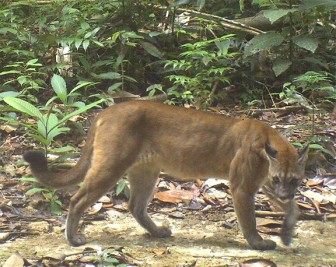With golden eyes and a tawny, golden colour the Puma (Puma concolor), is a long legged, rangy cat which ranges from North America to the tip of South America and exists at elevations up to 4,500 m, hence the name “mountain lion.”
Also known as the Florida Panther or Deer Tiger, it is white on the underside from the muzzle to the belly. The tip of the tail and behind the ears darken to black but the tail is also white on the underside of the tip. The tail can make up one third of the cat’s body length. The young are usually darker in colour with dark brown spots.
The puma is nocturnal and diurnal, terrestrial and solitary. Pumas can occasionally be seen walking down forested trails and roads in the Iwokrama Rain Forest and the Rupununi Savannahs. They don’t seem to like water and are not usually seen swimming or lounging on river banks like the Jaguar.
Like Jaguars and Peccaries, they mark their territory by scratching a patch of dirt and then spraying it with urine, and like other cats, will scratch both fallen logs and live trees.
They feed on large prey such as deer, agoutis and labba. They will also take smaller prey such as snakes and rats and in the savannah, can be a pest on ranches where they will take livestock.

Pumas will court and mate throughout the year, though their preference appears to be the months of December to March. A male, however, will not mate until he has established a home territory. Females give birth to 1 to 6 cubs every two years with the average being 3 to 4 in the litter. By a month and a half the cubs are weaned and can start eating meat. They will be with the mother for an average of fifteen months. Cubs reach sexual maturity at three years for males and two and a half years for females.
Although the puma is widespread in its range it is rarely seen as it is shy and wary; it has been driven to extinction in much of its former range in Eastern North America as a result of habitat destruction. Some of the subspecies are listed as CITES Appendix I while other are listed as Appendix II. The IUCN Red List evaluates their status as near threatened.
Rain forests are rich in biodiversity and are home to many different plants and animals as well as indigenous communities. Humans, even those who don’t live in the rain forest, rely on it for resources such as building materials (wood and lianas), medicine and fruits. Rain forests also provide essential environmental services for life on earth; they create soil as well as prevent soil erosion, produce oxygen though photosynthesis, maintain clean water systems, and are a key defence against climate change.
The Iwokrama Rain Forest is 371,000 hectares, located in the heart of Guyana. Our mission is to develop strategies for conservation and sustainable development for local people in Guyana and the world at large. We are involved in timber, tourism and training. Come and visit us in the rain forest or at http://www.iwokrama.org.




